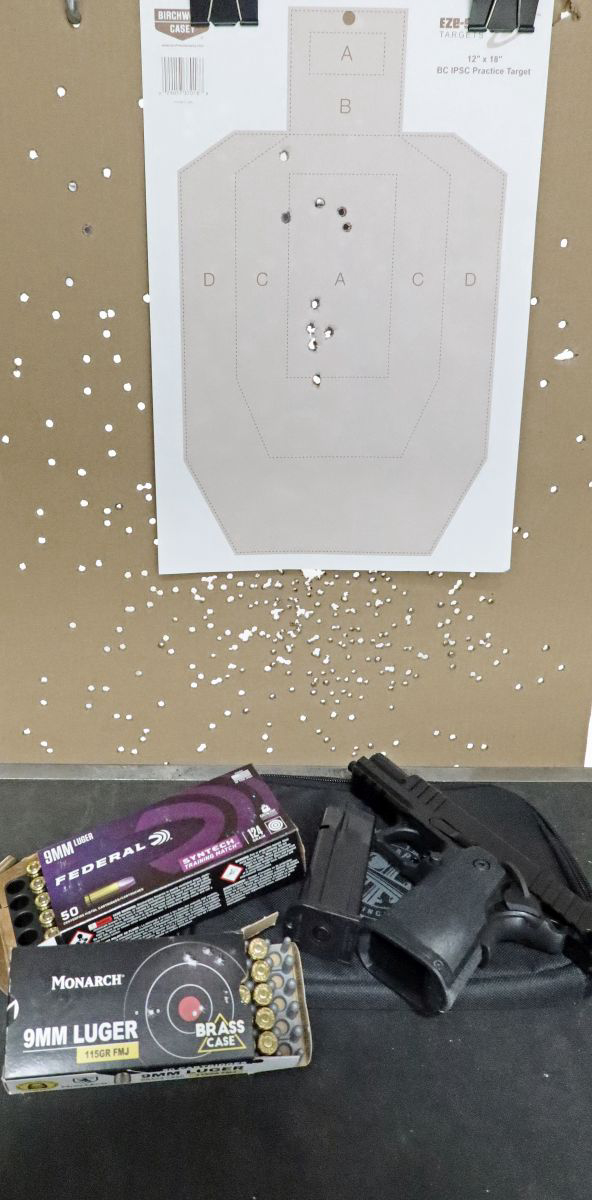We covered the announcement of the Springfield Armory Prodigy Compact here. Due to the weather-transportation interface in this thus far nasty winter, there was no range time with the new gun until I could get to an indoor range. Now, at least, I’ve been able to shoot the nice little double-stack 1911.
Like the name implies, it’s the double-stack 1911 9mm in more-or-less a G19-envelope. In this case, it’s not a “Commander-“equivalent. The grip frame is shorter, enhancing concealment. The present sample is the 4 ¼” upper; there’s a 3 ½” version as well.
Late in January, I took the new gun to an indoor facility. In my time on the range deck, I shot Federal Syntech Training Match 124 grain ammo and Monarch 115 grain FMJ “Brass Case” ammo.
I started with a 10-yard warmup to see where the sights were regulated. The Syntech load shot to sights at 10 yards; the effort, with flyer, produced a three-inch group. The best four hits shot into 1 7/8”.

The first ten rounds fired; top group from Federal Syntech and the bottom from Monarch FMJ-Brass Case.
I found the trigger to be firm and not at all heavy; the break is sharp. The sights are good as is, and the Prodigy Compact is cut for optics.
At the same distance, budget priced Monarch 115gr FMJ brass case shot into 2 ¼”, with four going into 1 3/8”.
Better ammo? No, likely the training effect – as these were the first ten rounds shot out of the gun. There is, perhaps, a preference for the lighter bullet weight, but that’s not particularly likely.
At 25 yards, hand-held, standing, the Monarch load shot into 4-inches. As I was on an indoor range, a seated position with a bag would have put the rounds higher on the backstop that I wanted.
The best three hits clustered into two inches.
Shooting the “Cirillo Drill” at seven yards with the Federal Syntech, I put seven of the 12 rounds into the three-inch “X” ring circle, with all rounds going into the four-inch circle. The drill calls for a pair of six round-magazines fired as follows:
1: A single from ready;
2: A pair from ready;
3: Three hits from ready; reload.
4: Six rounds in a single string.

The target from Werner’s Cirillo Drill.
The idea isn’t to shoot fast, it’s to shoot well. It’s a helpful warmup, handling drill and self-assessment and can be shot on an indoor range. Ideally, you each of those four strings from varying distances. I shot the sample at just seven yards.
I got this course and description from Claude Werner here. It’s worth doing with a new gun – to get a feel for it – and with your usual carry gun just for sustainment.
As to the Prodigy Compact, my concerns in dry practice handling of the gun didn’t appear in firing the piece. It’s not “feel” that matters, but “fit.”
My hands are such that I found some issues with grip on the Prodigy (which I have found with any double stack 1911). I was taught to “ride” the safety with my firing hand thumb, to keep the safety from getting kicked “on” during firing. There was a little discomfort there.
But, in shooting the Springfield Prodigy Compact, I found no such issues.
If a more-concealable double-stack 9mm 1911 is in your future, you should take a look at the Prodigy Compact.
— Rich Grassi